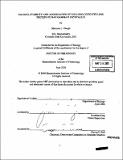| dc.contributor.advisor | Jonathan King. | en_US |
| dc.contributor.author | Flaugh, Shannon L | en_US |
| dc.contributor.other | Massachusetts Institute of Technology. Dept. of Biology. | en_US |
| dc.date.accessioned | 2008-02-28T16:26:03Z | |
| dc.date.available | 2008-02-28T16:26:03Z | |
| dc.date.copyright | 2006 | en_US |
| dc.date.issued | 2006 | en_US |
| dc.identifier.uri | http://dspace.mit.edu/handle/1721.1/34572 | en_US |
| dc.identifier.uri | http://hdl.handle.net/1721.1/34572 | |
| dc.description | Thesis (Ph. D.)--Massachusetts Institute of Technology, Dept. of Biology, 2006. | en_US |
| dc.description | Vita. | en_US |
| dc.description | Includes bibliographical references (p. 179-194). | en_US |
| dc.description.abstract | Human [gamma]D crystallin (H[gamma]D-Crys) is a monomeric, two domain, primarily P-sheet protein found in high concentrations in the human eye lens. H[gamma]D-Crys and other crystallins are found in insoluble protein inclusions associated with the eye disease cataract. H[gamma]D-Crys is expressed in utero and does not regenerate during life, thus necessitating high stability and solubility. Covalent damage, including glutamine deamidation, of the lens crystallins increases with age and as a result of exposure to environmental insults. Such covalent damage may cause partial-unfolding into aggregation-prone confomations that cause cataract. The in vitro stability of H[gamma]D-Crys was analyzed in the denaturant guanidine h[gamma]Drochloride at pH 7.0 and 370C. An off-pathway aggregation reaction that competed with refolding was previously reported when H[gamma]D-Crys was refolded to less than 1 M GuHC1. Equilibrium transitions of H[gamma]D-Crys were best fit to a three-state model suggesting the presence of a partially-folded intermediate that likely had a structured C-terminal domain (C-td) and unstructured N-terminal domain (N-td). Similarly, previous analyses revealed a sequential domain refolding pathway where the C-td refolds first followed by the N-td. | en_US |
| dc.description.abstract | (cont.) These findings suggest that the inter-domain interface of H[gamma]D-Crys is important in both folding and stability. The domain interface of H[gamma]D-Crys contains a central h[gamma]Drophobic cluster of six residues and two pairs of peripheral interacting residues. To test this importance of these residues in folding and stability, site-directed alanine mutants were constructed at all ten positions and properties of the mutant proteins were analyzed. Single mutations of h[gamma]Drophobic domain interface residues caused a decrease in stability of the N-td, but did not affect stability of the C-td. Similarly, stability of the N-td but not the C-td was reduced as a result of single and double mutations of peripheral interface residues. Minimal to no interaction energy was observed for the peripheral residues suggesting they contribute to stability indirectly, perhaps by shielding the central h[gamma]Drophobic cluster from solvent. Both the h[gamma]Drophobic and peripheral domain interface alanine mutants also had reduced rates of productive refolding for the N-td while refolding rates for the C-td were unchanged. These results suggest a productive folding pathway where the C-td refolds first and domain interface residues of the structured C-td act as a nucleating center for refolding of the N-td. | en_US |
| dc.description.abstract | (cont.) Effects on N-td refolding rates were most prominent for the h[gamma]Drophobic residues indicating the importance of proper h[gamma]Drophobic burial during refolding. The peripheral domain interface residues of H[gamma]D-Crys include a pair of two glutamines that are targets for covalent damage during aging. Deamidation mimics at these sites were constructed by site directed mutagenesis of glutamine to glutamate. Properties of the mutants were analyzed to assess the affects of deamidation on stability and folding. Similar to the alanine mutants at these sites, the deamidation mutants had a destabilized N-td but not C-td at pH 7.0. In contrast, stabilities of the mutants were indistinguishable from wild type at pH 3.0. The N-td of the deamidation mutants also unfolded faster than that of wild type during kinetic unfolding. These results indicate that deamidation of domain interface glutamines destabilizes H[gamma]D-Crys and lowers the kinetic barrier to unfolding. A reduction in the thermodynamic and kinetic stability as a result of domain interface deamidation could result in the population of partially-unfolded conformations in the lens that may aggregate through mechanisms such as domain swapping or loop-sheet insertion. | en_US |
| dc.description.statementofresponsibility | by Shannon L. Flaugh. | en_US |
| dc.format.extent | 211 p. | en_US |
| dc.language.iso | eng | en_US |
| dc.publisher | Massachusetts Institute of Technology | en_US |
| dc.rights | M.I.T. theses are protected by copyright. They may be viewed from this source for any purpose, but reproduction or distribution in any format is prohibited without written permission. See provided URL for inquiries about permission. | en_US |
| dc.rights.uri | http://dspace.mit.edu/handle/1721.1/34572 | en_US |
| dc.rights.uri | http://dspace.mit.edu/handle/1721.1/7582 | |
| dc.subject | Biology. | en_US |
| dc.title | Folding, stability and aggregation of the long-lived eye lens protein human gamma D crystallin | en_US |
| dc.type | Thesis | en_US |
| dc.description.degree | Ph.D. | en_US |
| dc.contributor.department | Massachusetts Institute of Technology. Department of Biology | |
| dc.identifier.oclc | 71204888 | en_US |
